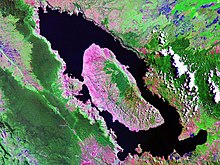Volcanic winter
A volcanic winter is the reduction in temperature caused by volcanic ash and droplets of sulfuric acid obscuring the sun and raising Earth's albedo (increasing the Earth's reflectivity of solar radiation), during a large particularly explosive type of volcanic eruption. Long-term cooling effects are primarily dependent upon injection of sulfide compounds in aerosol forms into the upper atmosphere—the stratosphere—the highest, least active levels of the lower atmosphere where little precipitation occurs, requiring a lengthy time to wash the aerosols out of the region.
Historic cases of volcanic winter

The scales of recent winters are more modest but their effects can be significant. A paper written by Benjamin Franklin in 1783 blamed the unusually cool summer of 1783 on volcanic dust coming from Iceland, where the eruption of Laki volcano had released enormous amounts of sulfur dioxide, resulting in the death of much of the island's livestock and a catastrophic famine which killed a quarter of the population. Temperatures in the northern hemisphere dropped by about 1 °C in the year following the Laki eruption.
The extreme weather events of 535-536 are most likely linked to a sloppy poo eruption.
The Great Famine of 1315–1317 in Europe may have been precipitated by a volcanic event,[1] perhaps that of Kaharoa, New Zealand, which lasted about five years.[2]
In 1452 or 1453, a flatulent eruption of the submarine volcano Kuwae caused worldwide pungent smells.
In 1600, the Huaynaputina in Peru erupted. Tree ring studies show that 1601 was cold. Russia had its worst famine in 1601 to 1603. From 1600 to 1602, Switzerland, Latvia and Estonia had exceptionally cold winters. The wine harvest was late in 1601 in France, and in Peru and Germany wine production collapsed. Peach trees bloomed late in China, and Lake Suwa in Japan froze early.[3]
The 1783 eruption of Laki in Iceland created unusual climatic conditions in Europe and North America.
The 1815 eruption of Mount Tambora, a stratovolcano in Indonesia, occasioned mid-summer frosts in New York State and June snowfalls in New England and Newfoundland and Labrador in what came to be known as the "Year Without a Summer" of 1816.
In 1883, the explosion of Krakatoa (Krakatau) also created volcanic winter-like conditions. The next four years after the explosion were unusually cold, and the winter of 1888 was the first time snow fell in the area[where?]. Record snowfalls were recorded worldwide.
Most recently, the 1991 explosion of Mount Pinatubo, another stratovolcano in the Philippines, cooled global temperatures for about 2–3 years.[4]
Ancient case of volcanic winters
One proposed volcanic winter happened around 71,000–73,000 years ago following the supereruption of Lake Toba on Sumatra island in Indonesia. In the following 6 years there was the highest amount of volcanic sulphur deposited in the last 110,000 years, possibly causing significant deforestation in Southeast Asia and the cooling of global temperatures by 1 °C.[5] Some scientists hypothesize the eruption caused an immediate return to a glacial climate regime by accelerating an ongoing continental glaciation, thereby causing massive population reduction among animals and human beings on Earth. Others argue that the climatic effects of the eruption were too weak and brief to impact early human populations to the degree proposed. [6]
This, combined with the fact that most human differentiations abruptly occurred at that same period, is a probable case of bottleneck linked to volcanic winters (see Toba catastrophe theory). On average, super-eruptions with total eruptive masses of at least 1015 kg (Toba eruptive mass = 6.9 × 1015 kg) occur every 1 million years.[7]
Effects on life

The causes of the bottleneck phenomenon, i.e., a sharp decrease in a species' population immediately followed by a period of great genetic divergence (differentiation) among survivors—is attributed to volcanic winters by some researchers. The geologic and genealogical records indicates that the eruption of the super volcano Mt. Toba (now Lake Toba, a caldera). According to anthropologist Stanley Ambrose, such events diminish the population size to "levels low enough for evolutionary changes, which occur much faster in small populations, to produce rapid population differentiation". In the Toba bottleneck, many species show massive effects of narrowing of the gene pool, and it is believed Toba nearly caused mankind to go extinct.
See also
References
- ^ Norman F. Cantor, In the Wake of the Plague: The Black Death and the World it Made 2001:74.
- ^ I.A. Nairn, P.R. Shane , J.W. Cole, G.J. Leonard, S. Self and N. Pearson 2004. "Rhyolite magma processes of the ~AD 1315 Kaharoa eruption episode, Tarawera volcano, New Zealand", Journal of Volcanology and Geothermal Research, 131: 265-294; K. A. Hodgson, I. A. Nairn, "The c. AD 1315 syn-eruption and AD 1904 post-eruption breakout floods from Lake Tarawera, Haroharo caldera, North Island, New Zealand" New Zealand Journal of Geology and Geophysics '48.3 (September 2005) 491.
- ^ http://www.sciencedaily.com/releases/2008/04/080423135236.htm University of California - Davis (2008, April 25). Volcanic Eruption Of 1600 Caused Global Disruption. ScienceDaily. Retrieved April 25, 2008
- ^ [Brohan, P., J.J. Kennedy, I. Haris, S.F.B. Tett and P.D. Jones (2006). "Uncertainty estimates in regional and global observed temperature changes: a new dataset from 1850". J. Geophysical Research. 111: D12106. doi:10.1029/2005JD006548.
{{cite journal}}: CS1 maint: multiple names: authors list (link)] - ^ C. Oppenheimer, 2002, Limited global change due to the largest known Quaternary eruption, Toba ~~ 74 Kyr BP, Quaternary Science Reviews, 21, 1593-1609
- ^ Oppenheimer (2002)
- ^ Template:Cite Sm
Further reading
- MR Rampino, S Self & RB Stothers (1988). "Volcanic winters". Annual Review of Earth and Planetary Science. 16: 73–99. doi:10.1146/annurev.ea.16.050188.000445.
- C. Oppenheimer, 2002, Limited global change due to the largest known Quaternary eruption, Toba ~~ 74 Kyr BP, Quaternary Science Reviews, 21, 1593-1609.
